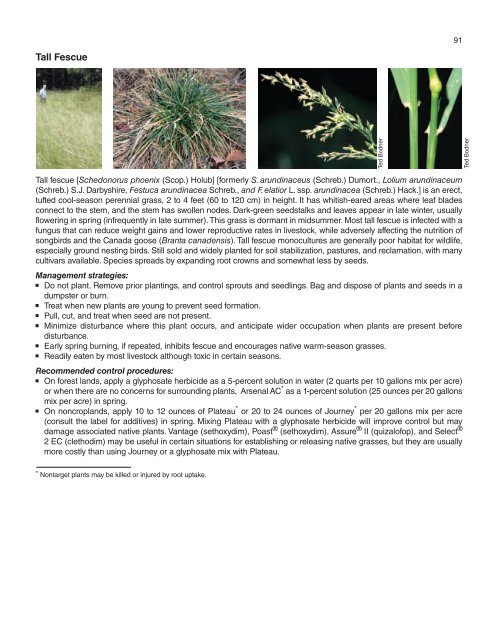90Nepalese Browntop, Japanese StiltgrassChris EvansChris OswaltTed BodnerNepalese browntop or Japanese stiltgrass [Microstegium vim<strong>in</strong>eum (Tr<strong>in</strong>.) A. Camus] is a sprawl<strong>in</strong>g, dense, mat-<strong>for</strong>m<strong>in</strong>gannual grass, 0.5 to 3 feet (15 to 90 cm) long with stems grow<strong>in</strong>g to 1 to 3 feet (30 to 89 cm) <strong>in</strong> height, often bend<strong>in</strong>g overand root<strong>in</strong>g at nodes to <strong>for</strong>m extensive <strong>in</strong>festations. It has alternate, lanceolate leaf blades to 4 <strong>in</strong>ches (10 cm) long withoffcenter ve<strong>in</strong>s and th<strong>in</strong> seed heads <strong>in</strong> summer and fall. Dried whitish-tan grass rema<strong>in</strong>s stand<strong>in</strong>g or matted <strong>in</strong> w<strong>in</strong>ter.One of the region’s most severe <strong>in</strong>vasive plants, it flourishes on alluvial floodpla<strong>in</strong>s and streamsides, mostly coloniz<strong>in</strong>gflood-scoured banks, due to water dispersal of seed and flood tolerance. It is also common <strong>in</strong> <strong>for</strong>est edges, roadsides,and trailsides, as well as damp fields, swamps, lawns, and ditches. It occurs up to 4,000 feet (1200 m) elevation and isvery shade tolerant. Consolidates occupation by prolific seed<strong>in</strong>g, with each plant produc<strong>in</strong>g 100 to 1,000 seeds that canrema<strong>in</strong> viable <strong>in</strong> the soil <strong>for</strong> up to 3 years. Hidden seeds with<strong>in</strong> leaf sheaves are produced <strong>in</strong> early summer. Spreads ontrails and recreational areas by seeds hitchhik<strong>in</strong>g on hikers’ and visitors’ shoes and clothes.<strong>Management</strong> strategies:Apply herbicide and mow<strong>in</strong>g treatments to stop seed production.Hand pull<strong>in</strong>g alone or hand pull<strong>in</strong>g followed by a summer herbicide application result <strong>in</strong> the most plant diversity comparedto broadcast glyphosate treatments, while control and diversity will only be ma<strong>in</strong>ta<strong>in</strong>ed with repeated hand pull<strong>in</strong>g.Treat when new plants are young to prevent seed <strong>for</strong>mation, and be aware that early summer self-poll<strong>in</strong>ated seedsare hidden <strong>in</strong>side the leaf sheaves.Clean shoes, clothes, dogs, and equipment of t<strong>in</strong>y seeds be<strong>for</strong>e leav<strong>in</strong>g <strong>in</strong>fested areas.M<strong>in</strong>imize disturbance with<strong>in</strong> miles of where this plant occurs, and anticipate wider occupation when plants are presentbe<strong>for</strong>e disturbance.Infestations result <strong>in</strong> a widespread and dense layer of f<strong>in</strong>e fuels <strong>in</strong> w<strong>in</strong>ter that can result <strong>in</strong> <strong>in</strong>tense fires caus<strong>in</strong>g damageto native plants. Prescribed burn<strong>in</strong>g can promote spread of exist<strong>in</strong>g <strong>in</strong>festations..Recommended control procedures:Apply a glyphosate herbicide as a 0.5- to 2-percent solution <strong>in</strong> water (2 to 8 ounces per 3-gallon mix) with a surfactant<strong>in</strong> early summer; or apply Fusilade ® DX or Plateau * (see label) <strong>in</strong> summer <strong>for</strong> situations that require more selectivecontrol and less impact on associated plants (hand weed<strong>in</strong>g a month prior to these treatments will <strong>in</strong>crease controland revegetation diversity).Repeat treatments <strong>for</strong> several years to control abundant germ<strong>in</strong>at<strong>in</strong>g seeds. Mow<strong>in</strong>g or pull<strong>in</strong>g just be<strong>for</strong>e seed setwill also prevent seed buildup <strong>in</strong> the soil seed bank. An early summer seed crop is hidden <strong>in</strong>side the leaf sheaves.* Nontarget plants may be killed or <strong>in</strong>jured by root uptake.
91Tall FescueTed BodnerTed BodnerTall fescue [Schedonorus phoenix (Scop.) Holub] [<strong>for</strong>merly S. arund<strong>in</strong>aceus (Schreb.) Dumort., Lolium arund<strong>in</strong>aceum(Schreb.) S.J. Darbyshire, Festuca arund<strong>in</strong>acea Schreb., and F. elatior L. ssp. arund<strong>in</strong>acea (Schreb.) Hack.] is an erect,tufted cool-season perennial grass, 2 to 4 feet (60 to 120 cm) <strong>in</strong> height. It has whitish-eared areas where leaf bladesconnect to the stem, and the stem has swollen nodes. Dark-green seedstalks and leaves appear <strong>in</strong> late w<strong>in</strong>ter, usuallyflower<strong>in</strong>g <strong>in</strong> spr<strong>in</strong>g (<strong>in</strong>frequently <strong>in</strong> late summer). This grass is dormant <strong>in</strong> midsummer. Most tall fescue is <strong>in</strong>fected with afungus that can reduce weight ga<strong>in</strong>s and lower reproductive rates <strong>in</strong> livestock, while adversely affect<strong>in</strong>g the nutrition ofsongbirds and the Canada goose (Branta canadensis). Tall fescue monocultures are generally poor habitat <strong>for</strong> wildlife,especially ground nest<strong>in</strong>g birds. Still sold and widely planted <strong>for</strong> soil stabilization, pastures, and reclamation, with manycultivars available. Species spreads by expand<strong>in</strong>g root crowns and somewhat less by seeds.<strong>Management</strong> strategies:Do not plant. Remove prior plant<strong>in</strong>gs, and control sprouts and seedl<strong>in</strong>gs. Bag and dispose of plants and seeds <strong>in</strong> adumpster or burn.Treat when new plants are young to prevent seed <strong>for</strong>mation.Pull, cut, and treat when seed are not present.M<strong>in</strong>imize disturbance where this plant occurs, and anticipate wider occupation when plants are present be<strong>for</strong>edisturbance.Early spr<strong>in</strong>g burn<strong>in</strong>g, if repeated, <strong>in</strong>hibits fescue and encourages native warm-season grasses.Readily eaten by most livestock although toxic <strong>in</strong> certa<strong>in</strong> seasons.Recommended control procedures:On <strong>for</strong>est lands, apply a glyphosate herbicide as a 5-percent solution <strong>in</strong> water (2 quarts per 10 gallons mix per acre)or when there are no concerns <strong>for</strong> surround<strong>in</strong>g plants, Arsenal AC * as a 1-percent solution (25 ounces per 20 gallonsmix per acre) <strong>in</strong> spr<strong>in</strong>g.On noncroplands, apply 10 to 12 ounces of Plateau * or 20 to 24 ounces of Journey * per 20 gallons mix per acre(consult the label <strong>for</strong> additives) <strong>in</strong> spr<strong>in</strong>g. Mix<strong>in</strong>g Plateau with a glyphosate herbicide will improve control but maydamage associated native plants. Vantage (sethoxydim), Poast ® (sethoxydim), Assure ® II (quizalofop), and Select ®2 EC (clethodim) may be useful <strong>in</strong> certa<strong>in</strong> situations <strong>for</strong> establish<strong>in</strong>g or releas<strong>in</strong>g native grasses, but they are usuallymore costly than us<strong>in</strong>g Journey or a glyphosate mix with Plateau.* Nontarget plants may be killed or <strong>in</strong>jured by root uptake.
















